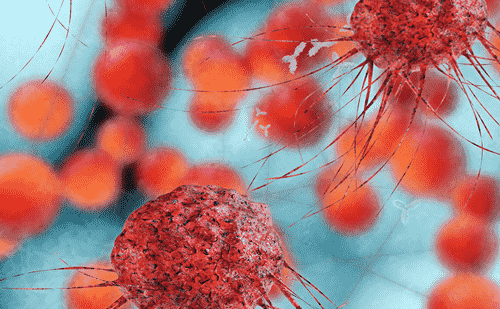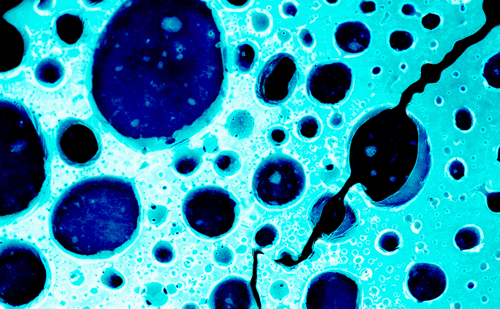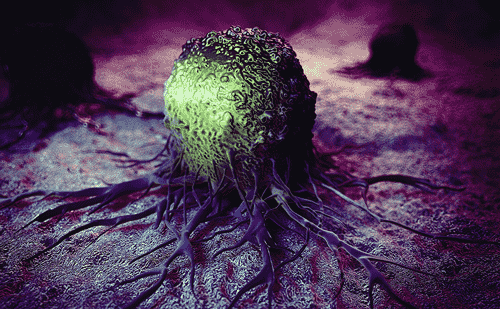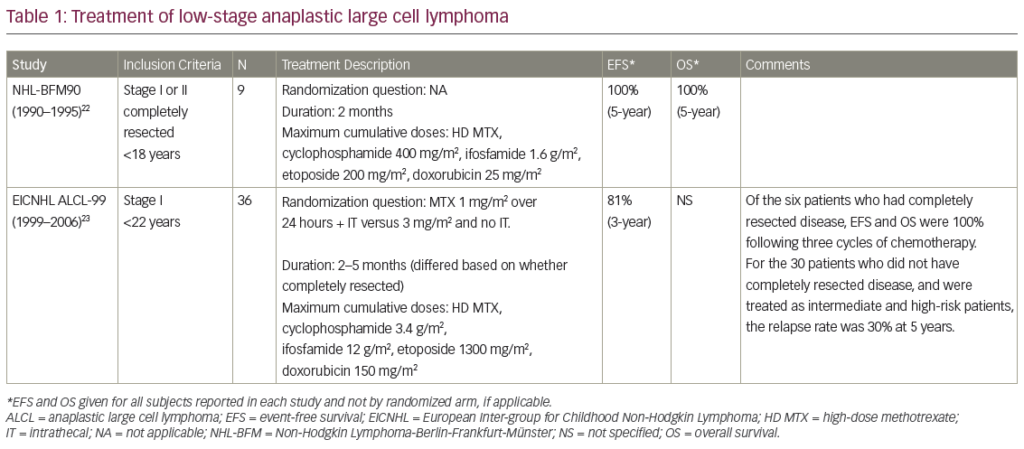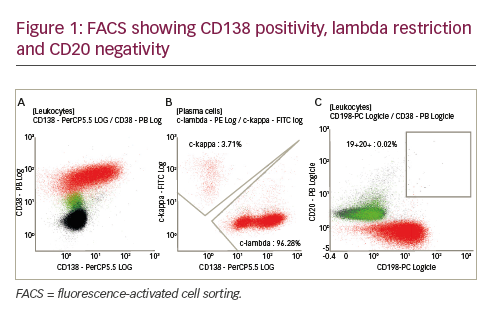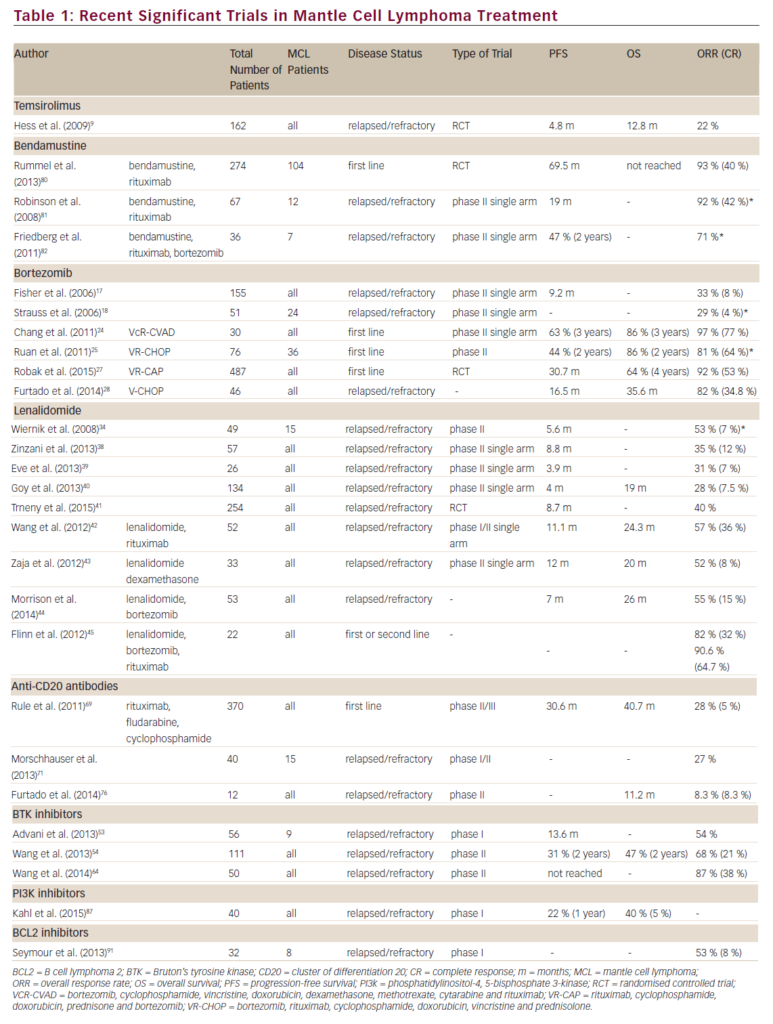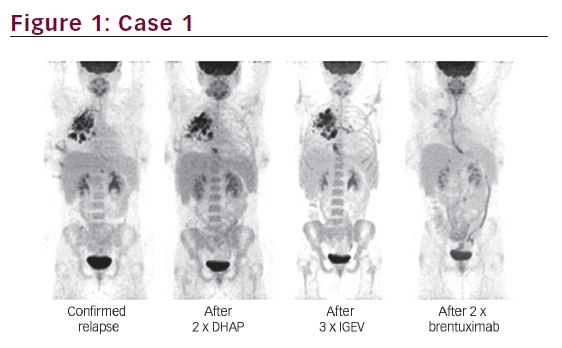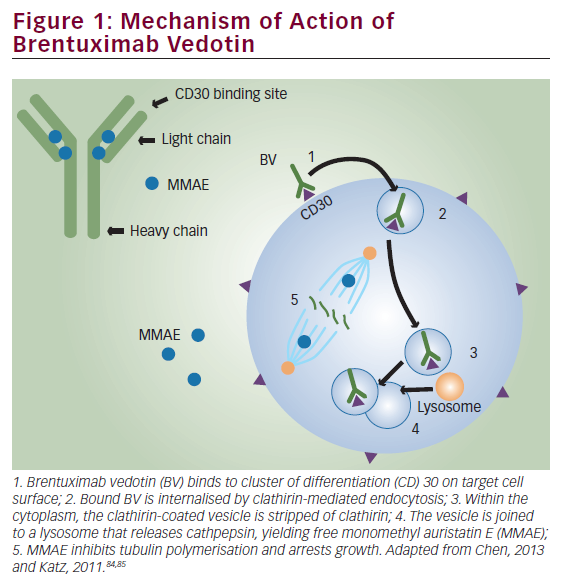The incidence of NHL has increased nearly two-fold over the past few decades, with AIDS-related lymphoma accounting for some of this expansion and environmental factors probably playing a role.3 NHL accounts for approximately 8–10% of all childhood malignancies.4 The prognosis of both localised and advanced childhood and adolescent NHL has improved considerably over the past 30 years.5,6
Follicular Lymphoma
Follicular lymphomas represent the second most frequent subtype of nodal lymphoid malignancies in Western Europe. The Non-Hodgkin’s Lymphoma Classification Project, which examined a cohort of 1,403 lymphoma biopsies from previously untreated NHL patients from nine sites worldwide, diagnosed FL in 22% of cases.7 Furthermore, in recent decades the annual incidence of FL has increased rapidly, rising from two to three per 100,000 persons during the 1950s to five per seven per 100,000 persons.8 The World Health Organization (WHO) classification of NHL separates follicular lymphoma into three grades based on the proportion of centroblasts in neoplastic follicles.9
FL grade 1 is diagnosed when up to five centroblasts per high-power (microscope) field (hpf) are counted, while FL grade 2 is diagnosed when six to 15 centroblasts per hpf are counted. FL grade 3 is characterised by more than 15 centroblasts per hpf, and it is subdivided into grade 3a when centrocytes are present and 3b when solid sheets of centroblasts are observed. FL grades 1, 2 and 3a are considered to be indolent, whereas 3b is considered to be an aggressive variant of FL. FL grade 3b has displayed similar histological features to the DLBCL component. In the presence of the DLBCL component, patients with FL grade 3b were less likely to harbour the t(14;18) translocation, which is quite common in the other grades, but were more likely to display aberrations in chromosome band 3q27 and overexpress the tumour suppressor gene p53.10
The current European Society for Medical Oncology (ESMO) guidelines recommend radiotherapy as first-line therapy in patients with limited stage I–II disease, and advise that systemic therapy should be considered in patients with large tumour burden.11 In patients with advanced stage III and IV disease, no curative therapy is yet established. In these patients, ESMO recommendations include the initiation of chemotherapy in combination with rituximab as first-line treatment only upon the occurrence of symptoms with the aim of inducing complete remission. Recommended chemotherapy regimens include cyclophosphamide plus doxorubicin, vincristine and prednisone (CHOP), cyclo-phosphamide, vincristine, prednisone (CVP) and purine analogue-based schemes such as fludarabine, cyclophosphamide and mitoxantrone (FCM) or bendamustine. Interferon-α maintenance therapy may have a benefit with regard to duration of response, which must be balanced against toxicity, while rituximab maintenance and autologous stem-cell transplantation (ASCT) is investigational in first-line therapy.11
Rituximab in conjunction with chemotherapy is the first-line treatment for advanced disease. Subsequent consolidation aims to stabilise remission once cytoreduction is achieved by induction treatment. The ultimate goal is to avoid relapse altogether, but currently this can only be postponed. In relapsed disease, the chosen salvage therapy is dependent on the efficacy of the initial regimen. A non-cross-resistant regimen, such as fludarabine or bendamustine after CHOP, is preferred in early relapses (<12 months). Rituximab should be added if the initial antibody-based regimen achieved a remission duration of more than six months. Moreover, rituximab maintenance has also demonstrated benefits in terms of progression-free survival (PFS) after initial rituximab/chemotherapy in the salvage situation. Myeloablative consolidation followed by ASCT may also prolong PFS in relapsed disease. The effects of high-dose therapy (HDT) with ASCT and rituximab were compared on two successive cohorts of patients with advanced FL treated by the same induction and consolidation regimen. The cohorts were from two randomised controlled trials that ran between 1986 and 1994 (the Groupe d’Etude des Lymphomes Folliculaires [GELF-86] study) and 1994 and 2001 (the Groupe d’Etude des Lymphomes de l’Adulte (GELA) study [GELF-96].12 HDT significantly improved event-free survival from relapse and survival after relapse (SAR). Interestingly, patients in relapse fared best when they received rituximab/chemotherapy plus HDT compared with immuno-chemotherapy or HDT alone. Patients treated with a rituximab containing salvage regimen followed by HDT had five-year SAR of more than 90%.12 These data suggest that HDT after rituximab/ chemotherapy may add additional clinical benefit, a question which will be addressed for intermediate-/high-risk FL-treatment-naïve patients by an international study (Ri-CHOP study) co-ordinated by the German Low-grade Lymphoma Study Group (GLSG): in this trial patients in need of therapy will be randomised to either R-CHOP followed by rituximab maintenance or R-CHOP followed by consolidating HDT and subsequent rituximab maintenance. Radioimmunotherapy (RIT) should also be considered in the consolidation setting in relapsed disease, particularly in antibody-refractory patients and in widespread disease following multiple prior therapies.11
The Follicular Lymphoma International Prognostic Index (FLIPI)13 was developed to predict the prognosis of patients with FL. Based on five easily obtained clinical and laboratory parameters such as age, Ann Arbor stage, number of nodal areas, LDH and haemoglobin levels, the FLIPI discriminates between three major subgroups of patients with FL with regard to overall survival, carrying a low- (none to one risk factors), intermediate- (two risk factors) or high-risk (three to five risk factors) factor.14 A recent analysis evaluated FLIPI’s predictive value in rituximab-treated advanced FL patients and found that FLIPI identified high-risk patients with advanced-stage FL after first-line treatment with rituximab chemotherapy.13 There are ongoing efforts to develop a novel prognostic score validated after rituximab chemotherapy.15
Antibody Therapy in Follicular Lymphoma
Rituximab is a chimaeric immunoglobulin G (IgG) kappa monoclonal antibody that recognises the CD20 antigen expressed on normal B cells and most malignant B-cell lymphomas.15 The addition of rituximab to the armamentarium of agents for the treatment of NHL has greatly improved management of the disease. Since its approval for clinical use in 1997, rituximab (either as part of induction treatment or as maintenance therapy)17–23 has improved response rates and prolonged OS in patients with follicular NHL and DLBCL.21 Ongoing research is being conducted to define the timing (schedule) and administration necessary for optimum treatment of hard-to-cure lymphomas.
However, nearly every third patient in the first-line setting25 and about half of patients at relapse19 do not respond to rituximab single-agent treatment, and virtually all patients suffer from recurrent disease or progress at some time after rituximab treatment, revealing the critical need to improve and enhance the efficacy of monoclonal antibody activity. RIT is a new modality of targeted therapy in which conjugated radioisotopes to anti-CD20 antibodies are delivered to tumour targets.The Rituximab Era
Evidence from several clinical trials lead to the same conclusion: rituximab plus chemotherapy is more efficient than chemotherapy alone for improving remission rates, duration of response and OS in FL as first-line treatment. Hiddemann et al. randomised 428 patients with untreated, advanced-stage FL for chemotherapy with CHOP alone or CHOP combined with rituximab (R-CHOP).26 The R-CHOP combination reduced the relative risk of treatment failure by 60%, and significantly prolonged the time to treatment failure.
The addition of rituximab to CVP increased both complete and overall response rates (ORR), and prolonged the median time to disease progression (34 months versus 15 months) compared with CVP alone (p<0.0001). The four-year disease-free survival (DFS) rate for patients with a complete response/complete response unconfirmed (CR/CRu) was 54% with R-CVP versus 17% with CVP (p=0.0001). In addition, the four-year estimated OS rate was 83% with R-CVP versus 77% with CVP alone.27
In patients with previously untreated advanced FL, rituximab plus mitoxantrone, chlorambucil and prednisolone chemotherapy (MCP) demonstrated an ORR of 92% and a CR rate of 50% versus 75% ORR and 25% CR for MCP alone (p<0.0001). At 47 months median follow-up, the median event-free survival (EFS) time was significantly prolonged with R-MCP compared with MCP alone: EFS not reached versus 26 months, respectively (p<.0001). Similarly, PFS was significantly prolonged to 28.8 months with R-MCP, whereas it was not reached with MCP (p<0001). R-MCP also yielded a significantly improved four-year overall survival rate of 87% compared with the 74% achieved with MCP alone (p=0.0096).28
The final analysis of the GELA–GOELAMS FL2000 Study with a Five-Year Follow-up29 in previously untreated FL patients (n=359) demonstrated that cyclophosphamide, adriamycin, etoposide and prednisolone (CHVP) plus interferon-2α (IFN2α) and rituximab over 18 months was superior to CHVP plus IFN2α. After a median follow-up of five years, EFS estimates were 37 and 53% in the CHVP plus IFN2α and R-CHVP plus IFN2α arms, respectively (p=0.0004). Response duration in CR/CRu or partial remission (PR) patients at the end of the 18 months of treatment was also improved in the R-CHVP plus IFN2α arm (p=0.012). However, five-year OS estimates were statistically different between the two treatment arms only in patients with high-risk profiles according to the FLIPI.
Rituximab has proved successful as maintenance therapy for a number of reasons. First, it has low acute toxicity and no major long-term or cumulative toxicity has yet been described. Second, rituximab’s long half-life allows for infrequent maintenance treatments and retains long-term drug exposure.Several studies have evaluated rituximab’s efficacy as maintenance therapy in both the first-line and relapsed settings.30–34 These studies have reported promising data regarding ORR as well as PFS in a salvage situation. The important question of whether rituximab maintenance is beneficial after initial immunochemotherapy first-line therapy is addressed by the Primary Rituximab and Maintenance (PRIMA) trial, which has completed patient accrual. Its primary objective is the evaluation of maintenance therapy with rituximab in first-line patients with advanced FL after induction of response with rituximab–chemotherapy combination compared with no maintenance therapy. The results from this international open-label, multicentre, randomised study are expected in 2009.
Consolidation Therapy for Follicular Lymphoma
The aim of consolidation therapy is to further improve the quality of response, preferably with the eradication of minimal residual disease (MRD) after successful cytoreduction by chemotherapy. Myeloablative therapy before ASCT and RIT are two potential consolidation strategies that have been investigated in the clinical setting as both first- and second-line therapy. Consolidation therapy with rituximab as a single agent delivered short-term has not been established for either FL or aggressive lymphoma. As opposed to myelablative therapy followed by ASCT or RIT, which both take around 14 days, rituximab maintenance treatment continues over a period of two years.
Radioimmunotherapy
RIT is a treatment modality that combines the specificity of monoclonal antibodies against tumour antigens with therapeutic radioisotopes delivered to sites of disseminated disease. Encouraging results have been reported for the 90Y-labelled IgG1 κ anti-CD20 antibody ibritumomab tiuxetan and also for the 131I-labelled IgG2 κ anti-CD20 antibody tositumomab in the treatment of FL. Currently, only 90Y-ibritumomab tiuxetan is approved for use in Europe as single-agent therapy in patients with relapsed follicular lymphoma who have been treated with rituximab. It was recently approved for consolidation therapy after remission induction in previously untreated patients with follicular lymphoma. In the non-myeloablative approach, both agents have demonstrated comparable activity, with response rates of 60–80% and CR/CRu rates of between 4 and 15%, including patients who relapsed after or were refractory to previous chemotherapy and rituximab.35
Radioimmunotherapy as Consolidation Therapy
Studies evaluating RIT as consolidation therapy have shown promising data. A phase II trial of CHOP followed by tositumomab/ 131I-tositumomab for previously untreated FL in 90 eligible patients with previously untreated advanced-stage FL reported an OR of 91%, with a 69% CR rate. The estimated five-year OS rate was 87%, and the PFS rate was 67%.
These data were superior to corresponding figures for patients treated on previous Southwest Oncology Group protocols with CHOP alone.36 Interestingly, 21% of patients with FLIPI high-risk features had worse OS than lower-risk patients (p=0.05), although no differences were reported in PFS between FLIPI-stratified groups. Another phase II study evaluated the efficacy of abbreviated chemotherapywith fludarabine followed six to eight weeks later with tositumomab/131I-tositumomab. After the fludarabine course, 89% of 35 patients and 9% of 31 patients achieved CR. Following 131I-tositumomab consolidation therapy, all 35 patients responded and 86% achieved CR.37
A preliminary study evaluated 90Y-ibritumomab tiuxetan following CHOP–rituximab. After CHOP–rituximab, the CR rate was 28%. After RIT, the CR rate was 67%.38 Two-year PFS was 85%. A phase II study investigating the efficacy of fludarabine and mitoxantrone (FM) chemotherapy followed by 90Y-ibritumomab tiuxetan in patients with stage III or IV untreated indolent FL showed an ORR of 98% and a CR rate of 71% after FM chemotherapy. Of the patients who completed the sequential treatment (chemotherapy plus RIT), 97% achieved CR.39 At a median follow-up of 30 months, the estimated three-year PFS rate was 76%, and the three-year OS rate was estimated to be 100%.
Recently, the results of the first phase III trial evaluating RIT consolidation treatment were presented. The phase III First-line Indolent Trial (FIT) evaluated the efficacy and safety of 90Y-ibritumomab tiuxetan consolidation in patients with advanced FL responding to first-line chemotherapy.40 The multicentre study tested whether a single infusion of 90Y-ibritumomab tiuxetan would prolong PFS in patients responding to initial cytoreduction.
Major inclusion criteria were: CD20-positive grade 1 or 2 FL, stage III or IV at diagnosis, normal peripheral blood cell counts, <25% bone marrow involvement, age ≥18 years and CR/CRu or PR after first-line chemotherapy determined by physical examination, CT scans and bone marrow biopsy. After completing induction therapy that included various regimens, patients were randomised to receive either 90Y-ibritumomab tiuxetan (208 patients) or no further treatment (206 patients).
For patient subgroups in PR or CR after induction, median PFS was 6.3 versus 29.7 months (p<0.0001) and 29.9 versus 54.6 months (p=0.01), respectively, in favour of 90Y-ibritumomab tiuxetan treatment
After 90Y-ibritumomab tiuxetan consolidation, 77% of patients in PR after induction therapy converted to CR; in total, 87% of patients were in CR/CRu, 76% in CR and 11% in CRu. Toxicity encompassed primarily haematological effects. Median platelet count nadir was at 45x109/l approximately five weeks post-90Y-ibritumomab tiuxetan, and the median neutrophil nadir was 1.0x109/l almost six weeks post-RIT. Grade 3/4 infections occurred in 8% in the 90Y-ibritumomab tiuxetan arm versus 2% in the control arm. This is the first phase III study to convincingly show a benefit with RIT in the consolidation setting.
Further prospective studies are needed to confirm the potential benefits of RIT, particularly following rituximab chemotherapy. Following this line, a new international trial (the Randomized intergroup trial Zevalin [RitZ]) co-ordinated by the German Low-grade Lymphoma Study Group (GLSG) and the Dutch–Belgian Hemato–Oncology Co-operative Group (HOVON) will begin soon, testing whether a single infusion of 90Y-ibritumomab tiuxetan followed by rituximab maintenance will prolong duration of response after initial successful rituximab/chemotherapy compared with rituximab/chemotherapy followed by rituximab maintenance alone in patients with recurrent FL.
Follicular Lymphoma in the Future
One issue that will become the centre of attention in the future is the treatment of elderly and medically non-fit cancer patients. Due to the general ageing of the population in the western world, FL will become the burden of the elderly. The number of lymphoma patients aged between 65 and 90 years will increase and their treatment will present a serious challenge. Non-lymphoma-related co-morbidities such as heart and renal disease that are common in elderly patients will render high-dose intensive chemotherapy not feasible for their treatment. These patients urgently need a new concept of treatment, and monoclonal antibody therapy is an attractive alternative for these difficult-to-treat patients.

